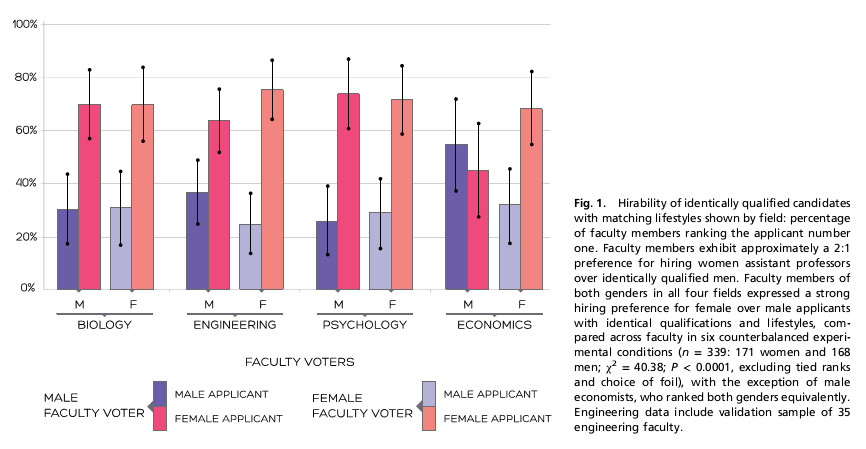National hiring experiments reveal 2:1 faculty preference for women on STEM tenure track
National hiring experiments reveal 2:1 faculty preference for women on STEM tenure track
by Wendy M. Williams and Stephen J. Ceci
Proceedings of the National Academy of Sciences of the United States of America, DOI10.1073/pnas.1418878112, April 13, 2015.
http://www.pnas.org/content/early/2015/04/08/1418878112.abstract
Significance
The underrepresentation of women in academic science is typically attributed, both in scientific literature and in the media, to sexist hiring. Here we report five hiring experiments in which faculty evaluated hypothetical female and male applicants, using systematically varied profiles disguising identical scholarship, for assistant professorships in biology, engineering, economics, and psychology. Contrary to prevailing assumptions, men and women faculty members from all four fields preferred female applicants 2:1 over identically qualified males with matching lifestyles (single, married, divorced), with the exception of male economists, who showed no gender preference. Comparing different lifestyles revealed that women preferred divorced mothers to married fathers and that men preferred mothers who took parental leaves to mothers who did not. Our findings, supported by real-world academic hiring data, suggest advantages for women launching academic science careers.
Abstract
National randomized experiments and validation studies were conducted on 873 tenure-track faculty (439 male, 434 female) from biology, engineering, economics, and psychology at 371 universities/colleges from 50 US states and the District of Columbia. In the main experiment, 363 faculty members evaluated narrative summaries describing hypothetical female and male applicants for tenure-track assistant professorships who shared the same lifestyle (e.g., single without children, married with children). Applicants' profiles were systematically varied to disguise identically rated scholarship; profiles were counterbalanced by gender across faculty to enable between-faculty comparisons of hiring preferences for identically qualified women versus men. Results revealed a 2:1 preference for women by faculty of both genders across both math-intensive and non–math-intensive fields, with the single exception of male economists, who showed no gender preference. Results were replicated using weighted analyses to control for national sample characteristics. In follow-up experiments, 144 faculty evaluated competing applicants with differing lifestyles (e.g., divorced mother vs. married father), and 204 faculty compared same-gender candidates with children, but differing in whether they took 1-y-parental leaves in graduate school. Women preferred divorced mothers to married fathers; men preferred mothers who took leaves to mothers who did not. In two validation studies, 35 engineering faculty provided rankings using full curricula vitae instead of narratives, and 127 faculty rated one applicant rather than choosing from a mixed-gender group; the same preference for women was shown by faculty of both genders. These results suggest it is a propitious time for women launching careers in academic science. Messages to the contrary may discourage women from applying for STEM (science, technology, engineering, mathematics) tenure-track assistant professorships.

